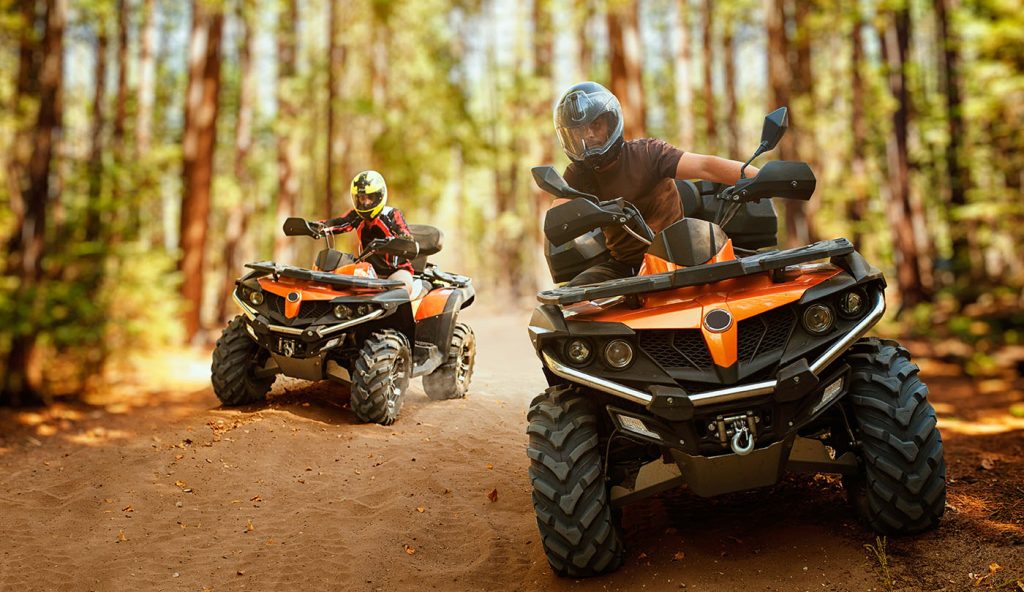ATV riding is an exhilarating outdoor activity that allows enthusiasts to explore rugged terrain and embrace the thrill of off-road adventure. However, with excitement comes responsibility, and prioritizing safety is paramount to ensure a positive riding experience for riders of all skill levels.
This comprehensive guide delves into the theory and practices of responsible ATV riding, covering essential safety principles, best practices, and practical tips to minimize risks and ensure safety.
UNDERSTANDING ATV DYNAMICS
Before hitting the trail, it’s crucial to understand the dynamics of ATV operation. ATVs have unique design and handling characteristics compared to other vehicles, such as motorcycles or cars.
Riders should familiarize themselves with the ATV’s controls, weight distribution, and center of gravity to maintain stability and control in various riding conditions.
WEARING PROPER SAFETY GEAR
Safety starts with proper gear. Every rider should wear a DOT-approved helmet, goggles or a face shield, gloves, long sleeves, pants, and over-the-ankle boots while riding an ATV.
Additionally, wearing protective gear such as chest protectors, knee and elbow pads, and a riding jacket can provide added protection against injuries in the event of a crash or rollover.
PERFORMING PRE-RIDE INSPECTIONS
Before each ride, conduct a thorough inspection of your ATV to ensure it’s in safe working condition. Start with tires, check whether it is properly inflated or not, inspect the brakes, lights, and controls, and look for any signs of damage or wear and tear.
Address any maintenance issues promptly to prevent mechanical failures or malfunctions while riding.
RIDING WITHIN YOUR SKILL LEVEL
Start your Riding at a pace that matches your skill level and experience. Avoid attempting maneuvers or tackling obstacles beyond your capabilities, as this can increase the risk of accidents or injuries.
You can gradually progress as you gain confidence and proficiency, and always prioritize safety over bravado.
FOLLOWING TRAIL ETIQUETTE
Respect trail etiquette and adhere to established rules and regulations while riding. Yield to other trail users, including hikers, equestrians, and cyclists, and maintain a safe distance from wildlife and sensitive habitats.
You must stay on designated trails and avoid trespassing on private property or environmentally protected areas.
AVOIDING RIDING ALONE
Riding alone increases the risk of injury or getting stranded in remote locations with no help available. Therefore, whenever possible, ride in a group of buddies.
Riding with others not only enhances safety but also provides camaraderie, assistance, and support in case of emergencies.
PRACTICING DEFENSIVE RIDING
Practice defensive riding techniques to anticipate and avoid potential hazards on the trail. Scan the terrain ahead for obstacles, hazards, and changes in conditions, and adjust your speed and direction accordingly.
Maintain a safe following distance from other riders. Always be prepared to react quickly to unexpected situations.
KNOWING YOUR LIMITS
Know your limits and recognize when it’s time to take a break or call it a day.
Fatigue, dehydration, and adverse weather conditions can impair judgment and increase the risk of accidents. Listen to your body and take regular breaks to rest, hydrate, and refuel before continuing your ride.
UNDERSTANDING ENVIRONMENTAL CONSIDERATIONS
Respect the environment and minimize your impact while riding. Stick to the designated trails to prevent soil erosion and habitat destruction and avoid disturbing wildlife or sensitive ecosystems.
Pack out all trash and leave no trace behind, preserving the natural beauty of the landscape for future generations to enjoy.
CONTINUING EDUCATION AND TRAINING
Stay informed and up-to-date on the latest ATV safety guidelines, regulations, and best practices. Consider taking an ATV safety course or participating in training programs offered by reputable organizations to enhance your riding skills and knowledge.
Investing in education and training can significantly improve safety and enjoyment while riding an ATV.
CONCLUSION
Safety is non-negotiable when it comes to ATV riding. By understanding the theory and practicing responsible riding techniques outlined in this guide, riders can minimize risks, prevent accidents, and ensure a safe and enjoyable riding experience for themselves and others.
Remember, safety first—because the thrill of adventure is best enjoyed when accompanied by peace of mind.

